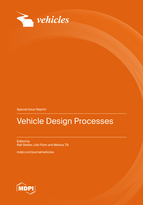Vehicle Design Processes
A special issue of Vehicles (ISSN 2624-8921).
Deadline for manuscript submissions: closed (20 December 2022) | Viewed by 54799
Special Issue Editors
Interests: autonomous vehicles; vehicle interior; vehicle ergonomics; vehicle seating systems; vehicle design processes; fault-tolerant control and design
Special Issues, Collections and Topics in MDPI journals
Interests: system theory; technical ethics; interdisciplinary design processes; functional modelling; environmental protection; digitalisation and artificial intelligence
Special Issues, Collections and Topics in MDPI journals
Interests: simulation; digital design processes; vehicle design processes; mechanisms for convertibles; multi-body analysis; finite lement analysis
Special Issues, Collections and Topics in MDPI journals
Special Issue Information
Dear Colleagues,
The design processes of vehicles are a promising research topic. The design of vehicles is one of the most challenging tasks in engineering because of several reasons. The enormous consumer expectations as well as the intensive global competition aggravates vehicle design. Cost-driven design is a necessity and vehicles need to be economical in production, operation, and recycling; in fact, sustainable design is also imperative for ecological vehicles. The dynamics of vehicles have to be considered in the design of all components and light-weight design is of fundamental importance. Consumers expect convincing functional performance, high product quality, appealing appearance, high reliability, interconnected functionality as well as comprehensible and appealing user interfaces. More and more, additional services are connected with vehicles. These enormous requirements lead to complex multi-domain design processes of vehicles, because most of the important decisions are made in the design phase. Production optimization and intelligent operation are important topics, but flaws and insufficiencies in the design stage lead to enormous expenditures in later stages and less-than-perfect products. The design processes of vehicles involve thousands of engineers are spread globally and need to consider multiple product versions and variants as well as multi-company product platforms. Very often, testing necessities and legal issues play an important role in these processes and the economic and ecological quality of the product has to be monitored throughout the processes. Even in early stages, vehicle safety and ergonomic quality need to be considered. Needless to say, only digital support makes these processes feasible. For all domains, powerful computer tools for synthesis, analysis, evaluation, and optimization were created and numerous attempts try to sensibly link the data used in all these tools. However, many domain specific and generic data formats as well as the sheer size of the data still create serious problems. It is important to note that design is also connected with scheduling and project management, because certain design decisions can lead to long-term testing and production preparation processes. The listed challenges concerning the multi-domain design processes of vehicles lead to a prominent need for research activities aimed at supporting the designers in this endeavor. This Special Issue intends to present the current status of these research activities. They will range from application-oriented attempts to improve certain design tools over process improvement attempts to fully integrated digital processes as well as novel approaches in this field such as big data and artificial intelligence. We are looking forward for your excellent research papers.
Prof. Dr. Ralf Stetter
Prof. Dr. Udo Pulm
Prof. Dr. Markus Till
Guest Editors
Manuscript Submission Information
Manuscripts should be submitted online at www.mdpi.com by registering and logging in to this website. Once you are registered, click here to go to the submission form. Manuscripts can be submitted until the deadline. All submissions that pass pre-check are peer-reviewed. Accepted papers will be published continuously in the journal (as soon as accepted) and will be listed together on the special issue website. Research articles, review articles as well as short communications are invited. For planned papers, a title and short abstract (about 100 words) can be sent to the Editorial Office for announcement on this website.
Submitted manuscripts should not have been published previously, nor be under consideration for publication elsewhere (except conference proceedings papers). All manuscripts are thoroughly refereed through a single-blind peer-review process. A guide for authors and other relevant information for submission of manuscripts is available on the Instructions for Authors page. Vehicles is an international peer-reviewed open access quarterly journal published by MDPI.
Please visit the Instructions for Authors page before submitting a manuscript. The Article Processing Charge (APC) for publication in this open access journal is 1600 CHF (Swiss Francs). Submitted papers should be well formatted and use good English. Authors may use MDPI's English editing service prior to publication or during author revisions.
Keywords
- design processes
- vehicle design
- design engineering
- digital design
- robotics
- product data management
- multi-domain design processes
- vehicle dynamics
- vehicle safety
- vehicle ergonomics
Related Special Issue
- Vehicle Design Processes, 2nd Edition in Vehicles (1 article)








